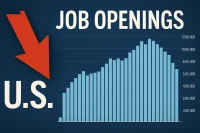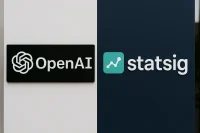In what experts are calling an unprecedented Gen Z job market crisis, recent graduates are facing the worst employment landscape in over a decade. With unemployment rates for young workers more than double the national average and AI poised to eliminate nearly half of all entry-level positions within the next five years, Gen Z is confronting a future vastly different from what they were promised.
The Devastating Reality of the Gen Z Job Market Crisis
The Wall Street Journal recently reported that Gen Z graduates are experiencing the most challenging employment conditions in over a decade. This Gen Z job market crisis is characterized by staggering unemployment rates, diminishing opportunities, and a fundamental restructuring of how companies approach entry-level hiring.
While 72% of Gen Z lives paycheck to paycheck, nearly half are working three or more jobs just to survive. This raises a critical question: why is Gen Z yet another generation promised a future that no longer exists?
The Broken Job Application Process
Despite 75% of employers claiming they’re struggling to fill vacancies—the second highest rate in two decades—the reality for job seekers tells a different story. A 2022 study examining over 300 job applications submitted by Business.com’s departing interns revealed that only 12% received any response from employers, just 5% expressed interest in the applicant, and not a single application resulted in a hire.
Even more troubling, employers were more likely to ghost candidates if the graduate met over 90% of the listed requirements, highlighting a fundamental disconnect in the Gen Z job market crisis.
Ghost Jobs: The Hidden Dimension of the Gen Z Job Market Crisis
Job postings have been weaponized throughout modern history, most notably during the civil rights era when employers flooded local job boards to portray government compliance. Today, this manipulation has evolved into what’s known as “ghost jobs”—a practice that has become normalized in corporate recruiting strategies.
The Alarming Scale of Fake Listings
In a recent survey by My Perfect Resume, an astonishing 81% of recruiters admitted their organization had posted fake job listings, with 21% acknowledging that half their listings had no intention of resulting in a hire. This deceptive practice is a central component of the Gen Z job market crisis.
While some ghost jobs are simply outdated postings, many are deliberately created as strategic tools generating billions in hidden profits. According to an analysis by workforce analytics firm Rellio Labs, online job listings in 2024 were only half as likely to result in a hire as they were in 2020, demonstrating how widespread these deceptive practices have become.
The Disturbing Motivations Behind Ghost Jobs
Companies employ ghost jobs for several troubling reasons:
- 60% use them to make employees believe their workload would be alleviated by new hires
- 62% post them to make current employees feel replaceable
- 43% create them to give the perception their company is thriving despite economic uncertainty
- 85% go as far as interviewing candidates despite not actively hiring
- Nearly 70% admitted posting fake listings boosted revenue
- 77% reported increased productivity among workers who feared losing their jobs
- 70% believe this practice is morally acceptable
The Library of Congress has officially recognized ghost jobs as a serious concern, yet despite job scams and fake employment agency fraud increasing from $90 million in 2020 to over $500 million in 2024, no federal legislation has been introduced to address this aspect of the Gen Z job market crisis.
Data Harvesting: The Unseen Dimension of the Gen Z Job Market Crisis
Beyond ghost jobs, the modern hiring process has evolved into a sophisticated data harvesting operation. Journalist Bob Sullivan notes that every week, data from 75% of Fortune 500 companies, 85% of the federal workforce, and countless institutions flows into databases tracking everything from social security numbers and salaries to healthcare coverage and job tenure.
Global Exploitation of Job Seekers’ Data
The exploitation extends globally. In Japan, Rukunabi, a major job-seeking platform catering to college graduates, was caught selling predictive scores gathered through job applications to approximately 40 corporations, including Toyota and Mitsubishi. These scores estimated how likely each applicant was to decline a job offer or withdraw their application.
This practice is particularly concerning in Japan’s lifetime employment system, which promises job security for life in exchange for loyalty to a single company. The sale of these scores had an immeasurable impact on candidates’ entire career paths.
Notably, Rukunabi is a subsidiary of Recruit Group, the same media conglomerate that owns both Indeed and Glassdoor, raising questions about data practices in the U.S. job market where privacy laws are less stringent.
The Vanishing Entry-Level Opportunity in the Gen Z Job Market Crisis
Unlike America’s post-war economic expansion, when hard work and dedication provided stable careers with upward mobility, today’s Gen Z job market crisis is characterized by the disappearance of true entry-level opportunities.
The Collapse of Internal Advancement
Only 15% of current vacancies are filled with internal candidates—a 75% decrease over the last 50 years—with companies now relying more on outside hiring and favoring those with years of experience. This shift has effectively sold off the bottom rung of the career ladder, making it nearly impossible for Gen Z to gain a foothold.
Scott Deutman, CEO of Avenia, a U.S.-based career platform for new graduates, explains: “Employers are unhappy with the level of talent they’re getting in the entry-level space. So, instead of trying to take corrective action, they’ve increased experience requirements. In the last 5 years, we’ve seen a 20% increase in the number of skills required on job listings.”
The Experience Paradox
A study by Generation, a nonprofit network focused on economic mobility, found that of 1,300 employers surveyed across eight countries (including the U.S. and UK), 94% required applicants for entry-level tech jobs to already have experience in a related field. More broadly, out of 3.8 million jobs on LinkedIn, roughly 38.4% of entry-level positions required 3-5 years of experience.
This paradox has forced young workers to depend entirely on internships as prerequisites for employment. Companies like Surface Now report a 50% increase in internship applications, while Citadel saw applications rise by 65%, ultimately accepting just 300 of the 69,000 applications received—a 0.4% acceptance rate.
The Global Nature of the Gen Z Job Market Crisis
This increasingly competitive and misaligned job market isn’t just affecting Gen Z in the United States—it’s part of a broader global trend exacerbating the Gen Z job market crisis worldwide:
- In Canada, youth unemployment has reached 12.2%, more than twice the rate of the prime working-age population
- In China, youth unemployment stands at 15.8%, prompting many Gen Z to adopt the label “rat people”—a satirical response to the overwhelming pressure of competing in a system where meaningful career opportunities are rapidly disappearing
AI and Automation: The Looming Threat to the Gen Z Job Market Crisis
As nearly three-quarters of hiring managers continue to consider Gen Z the most difficult generation in the workforce, employers are making a calculated bet that AI will evolve fast enough to replace entry-level talent altogether.
The Training Investment Gap
Unlike previous generations who were hired based on work ethic with the expectation that job-specific skills would be taught on the job, today’s employers are severely reducing their already limited training programs.
A 2021 report from the Organization for Economic Cooperation and Development revealed that while most nations spend an average of 0.62% of their GDP on active labor market programs like job training, employment incentives, and public hiring initiatives, the United States spends less than 0.1%—the same as Chile.
The Accelerating Displacement
Despite estimates that 50% of entry-level jobs could be eliminated within the next 1-5 years, the broader rise of automation and artificial intelligence is projected to displace another 45.3 million workers by 2030.
While many in Silicon Valley compare these technological advancements to past disruptions like cars or calculators, the reality is that the unprecedented speed of change is eliminating entire categories of work that once served as stepping stones for career advancement.
The Economic Reality for Gen Z in the Job Market Crisis
The Gen Z job market crisis is compounded by stagnant wages and rising costs, creating a perfect storm of economic hardship.
Declining Purchasing Power
Since 1970, the U.S. dollar has lost roughly 85% of its value, with 25% of that erosion occurring just in the past decade. Despite nominal wage increases, productivity has increased 80% between 1979 and 2024, while wages have only grown by 29.4%, equating to an annual inflation-adjusted increase of just 0.2%.
The Debt Burden
According to a recent report from Newsweek, Gen Z carries the highest average personal debt at $94,111, far above millennials at $59,181 and Gen X at $53,255. Compared to just a decade ago, Gen Z is paying:
- 31% more for housing
- 46% more for health insurance
- Over twice as much for car insurance
- Projected to spend roughly $145,000 in rent just by age 30, compared to $126,000 for millennials at the same age
If current trends persist, after-tax, after-healthcare income for the average family is projected to decline by 37% by 2030, with rising healthcare costs accounting for most of the loss.
Historical Context: Empty Promises in the Gen Z Job Market Crisis
The current Gen Z job market crisis follows decades of unfulfilled promises about better jobs for future generations:
- During Reagan’s two terms, despite creating 16.1 million jobs, only 28% were considered high-wage occupations, with the remaining 12.5 million concentrated in low-wage service work
- During Clinton’s presidency, even with 22 million jobs created, between 40-45% were low-skill, low-wage service roles
- After the Great Recession, mid-wage occupations accounted for 60% of jobs lost but just 27% of those regained, while low-wage jobs made up only 21% of losses but accounted for 58% of new jobs created
This pattern proves that Gen Z is not only competing for increasingly worse jobs, but the belief that better jobs are just around the corner remains an overly optimistic fantasy.
Hiring Based on Skills, Not Just Resumes?
The future of hiring is skills-first. Reach talented candidates who’ve earned their expertise through coding bootcamps, certifications, and hands-on training. Whether you’re building a tech team, growing your operations, or hiring remote freelancers—find the right fit faster.
🚀 Post a Skills-Based Job on WhatJobsFAQ: Understanding the Gen Z Job Market Crisis
What factors are contributing to the current Gen Z job market crisis?
The Gen Z job market crisis is fueled by multiple interconnected factors: the proliferation of ghost jobs (fake job listings), increasingly unrealistic experience requirements for entry-level positions, the rapid advancement of AI and automation threatening to eliminate up to 50% of entry-level roles within five years, stagnant wages failing to keep pace with productivity, and the systematic dismantling of internal promotion pathways. Additionally, the widespread practice of data harvesting through job applications has transformed the hiring process into a profit center rather than a genuine recruitment tool, further exacerbating the Gen Z job market crisis by creating an environment where applications often lead nowhere.
How are ghost jobs impacting the Gen Z job market crisis?
Ghost jobs are significantly worsening the Gen Z job market crisis by creating a false impression of opportunity while wasting candidates’ time and resources. According to research, 81% of recruiters admit their organizations post fake job listings, with 21% acknowledging that half their listings have no intention of resulting in a hire. These deceptive practices serve multiple corporate purposes: making current employees feel replaceable (62%), creating false perceptions of company growth (43%), and harvesting applicant data for profit. The prevalence of ghost jobs has reduced the likelihood of online applications resulting in hires by 50% since 2020, fundamentally undermining the job search process during this Gen Z job market crisis.
What role is AI playing in the Gen Z job market crisis?
Artificial intelligence is accelerating and deepening the Gen Z job market crisis in several ways. First, employers are increasingly betting that AI will soon eliminate the need for entry-level talent altogether, with projections suggesting 50% of entry-level jobs could disappear within 1-5 years. Unlike previous technological disruptions that occurred gradually, AI advancements are eliminating entire categories of traditional entry-level work at unprecedented speed. Additionally, companies are reducing training investments (the U.S. spends just 0.1% of GDP on job training programs) while simultaneously increasing experience requirements for remaining positions. This creates a paradoxical situation where Gen Z needs experience to get jobs, but the traditional pathways to gaining that experience are rapidly disappearing in the current Gen Z job market crisis.
What economic challenges is Gen Z facing as a result of this job market crisis?
The economic impact of the Gen Z job market crisis is severe and multifaceted. Gen Z carries the highest average personal debt at $94,111 (compared to $59,181 for millennials and $53,255 for Gen X) while facing dramatically increased costs: 31% more for housing, 46% more for health insurance, and double the cost for car insurance compared to a decade ago. Despite productivity increasing 80% since 1979, wages have grown just 29.4%, creating a widening gap between work output and compensation. With 72% of Gen Z living paycheck to paycheck and nearly half working three or more jobs to survive, the financial strain is unprecedented. If current trends continue, after-tax, after-healthcare income for the average family could decline by 37% by 2030, suggesting the Gen Z job market crisis will have long-lasting economic consequences for an entire generation.




